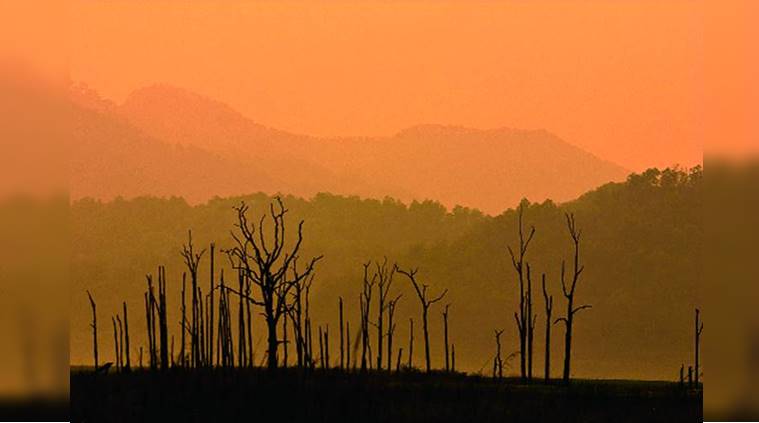 Who growls there? The sun sets over Jim Corbett National Park.
Who growls there? The sun sets over Jim Corbett National Park.
Corbett National Park is famed for the number of tigers it plays host to. But this causes tourists to think of the park only in terms of ‘tiger-spotting’, ignoring its other delights. While tracking tigers in an open Gypsy is a pulsating affair, the act of being confined to a Gypsy is a major handicap for anyone looking to get a true feel of the forest. Which is why I decided to step out of the security of a jeep, and meet the denizens of the forest on foot — yes, by walking.
As one might rightly expect, walking inside the demarcated perimeter of a national park isn’t permissible. But nature has little regard for man-made boundaries, always managing to find a way to thrive beyond delineated lines on paper. It was precisely one of these fringe areas — seven kilometres north as the crow flies to Corbett National Park’s Durgadevi gate, near Marchula village — that I chose for my maiden jungle walk. One can easily locate this trail by getting in touch with the staff of Van Ghat river lodge. Their property is the starting point of the trail — one need not necessarily book a room in their lodge to gain access to its surroundings. The village of Baluli — a half an hour walk from Van Ghat — is where accommodation can be alternatively sought at a homestay.
Although summer was in full swing, there was a slight nip in the air when I tentatively set out to scour the jungle with Mukesh, one of the guides employed by the lodge. The first signs of animal life I came across was in the form of a burrow that was said to be inhabited by a porcupine. Just as Mukesh and I began to weigh our chances of spotting the nocturnal resident, we were startled by a bird of deep-brown that whizzed past us. It turned out to be an owl, but unlike any Mukesh had ever seen before. The fact that we had stumbled upon a creature so rare, that even Mukesh’s enviable knowledge of birds proved insufficient in determining the exact species, had me excited as we plodded on.
Mukesh suddenly stopped me in my tracks and pointed towards a rocky incline leading up to our right. “A tiger was spotted slumbering here a couple of months back” he said. Soon, we were crossing the Ramganga river, which wound its way through this side of the park, and, in a way, split the neighbouring jungles into two. I asked Mukesh whether crocodiles take refuge in this stretch of the river and he answered in the affirmative. But reassuringly, he added that it was only a solitary individual — possibly a straggler — and was spotted only during the monsoons, when the river is in full spate. On crossing the river, I found myself clambering up a slippery slope, in order to reach higher ground. We could now survey the bank, the river and the forested stretches adjoining them, from an elevation.
Eventually, we came across an upward sloping incline that bent from left to right. And right in front of me was a Great hornbill in flight, laboriously flapping its heavy wings, its plumage a mix of yellow, black and white.
Then, after passing by what seemed to be the definite trails of an elephant, we heard the sound of dry leaves getting trampled on from the undergrowth ahead of us. Had the elephant scheduled another entry? But my guide put my frayed nerves to rest — he showed no signs of worry. In the next split second we knew who the culprit was — a mountain goat, commonly known as a goral. It was a rare sight because gorals usually restrict themselves to high, inaccessible cliff faces. As the fading rays of twilight began to set in, we chose to call it a day.
I set out early next morning for another jaunt. This time I was accompanied by Puran — a resident of nearby Baluli. Our sweat-soaked shirts indicated how hot it was — which was good news, for we knew that the jungle folks were anything but immune to the rising mercury. The tiger is especially known for its intolerance to high daytime temperatures. With this in mind, Puran and I stationed ourselves at two different spots, overlooking two different stretches of the river, since neither of us could reach a consensus on the matter of choosing the most favourable spot. This also meant that the chances of both my guide and I spotting a feline at the same time were nearly nil. And as luck would have it, that is exactly what happened. The moment Puran’s incomprehensible vocalisations fell upon my ears, I knew that the badshah had taken centre stage. But instinctively, I stayed put — Puran was about half a mile away, and any move to get to where he was would be futile on my part. I sat disconsolate, as the callings ceased, unabashedly cursing my fate, when a dung beetle scurried into view. It was engrossed in the act of manoeuvering its perfectly spherical ball of dung to its desired location. It was no tiger, but watching the indomitable bug wrestle its hoardings past the numerous obstacles scattered all over its route, was a sight as awe-inspiring as any, including that of a big cat.
The jungle had taught me an important lesson: before you set out into the wild, leave behind your vain baggage of expectations.